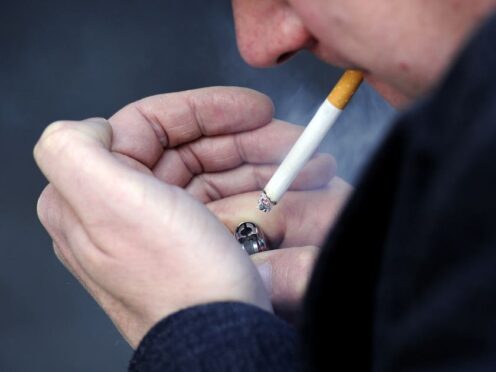
Smokers may have more belly fat – particularly visceral fat – compared to those who do not smoke, research suggests.
Visceral fat is the fat that surrounds the internal organs in the abdomen and is linked to a higher risk of heart disease, diabetes, stroke and dementia.
It can be hard to see, scientists say, as a person can still have a flat stomach and carry unhealthy amounts of visceral fat, raising the risk of serious illness.
And while smokers tend to have lower body weights than non-smokers, they also have more abdominal visceral fat, they add.
The study, published in the journal Addiction, found that both starting smoking and lifetime smoking may increase visceral fat.
The team, at the University of Copenhagen’s NNF Center for Basic Metabolic Research, looked at data from European ancestry studies involving 1.2 million people who started smoking and over 450,000 lifetime smokers.
They also looked at data from a body fat distribution study, which included over 600,000 people, along with information on their waist-to-hip ratio and waist and hip circumference.
The researchers used a form of statistical analysis called Mendelian randomisation to determine whether smoking causes an increase in abdominal fat using genetic information.
Lead author Dr German D Carrasquilla said: “This study found that starting to smoke and smoking over a lifetime might cause an increase in belly fat, as seen by measurements of waist-to-hip ratio.
“In a further analysis, we also found that the type of fat that increases is more likely the visceral fat, rather than the fat just under the skin.”
He said the influence of smoking on belly fat seems to happen regardless of other factors such as socioeconomic status, alcohol use, attention deficit hyperactivity disorder (ADHD) or how much of a risk-taker someone is.
Dr Carrasquilla added: “From a public health point of view, these findings reinforce the importance of large-scale efforts to prevent and reduce smoking in the general population, as this may also help to reduce abdominal visceral fat and all the chronic diseases that are related to it.
“Reducing one major health risk in the population will, indirectly, reduce another major health risk.”
Meanwhile, another study suggests tobacco exposure before birth and beginning smoking during childhood or adolescence is associated with the development of Type 2 diabetes later in life.
The preliminary findings, presented at the American Heart Association’s Epidemiology and Prevention: Lifestyle and Cardiometabolic Scientific Sessions 2024 conference, are based on data from almost 476,000 adults in the UK Biobank, which holds medical and lifestyle records of half a million Britons.
Researchers found those who started smoking in childhood had double the risk of type 2 diabetes compared to those who never smoked, while those who started smoking as adolescents had a 57% higher risk and those who picked up the habit during adulthood had a 33% increased risk.

Enjoy the convenience of having The Sunday Post delivered as a digital ePaper straight to your smartphone, tablet or computer.
Subscribe for only £5.49 a month and enjoy all the benefits of the printed paper as a digital replica.
Subscribe